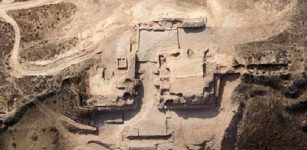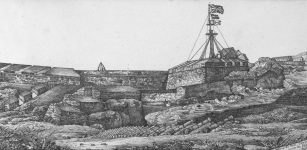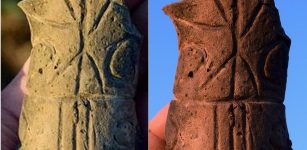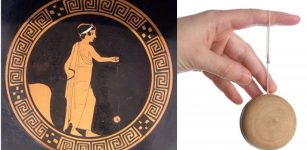Who Were The Hoplites And What Was Their Armor Composed Of?
Conny Watets - AncientPages.com - A new type of foot soldier emerged around 800 BC in Greece when the country was still recovering after the fall of Mycenaean civilization around 1200 BC.
These new soldiers, usually farmers, who owned small (about ten acres) pieces of land, were included in the Greek police forces.
Hoplite warriors. Credit: Adobe Stock - AlienCat - Image right: Adobe Stock - Massimo Todaro
These farmers were important citizens of the country because - as one strong group - they decided the laws that ruled the communities and joined together to fight in the tines of war.
They were called hoplites, and each member was known as a hoplite warrior. His name originated from the round shield or “hoplon” the soldier carried. The hoplon was three feet (approximately one meter) in diameter.
According to the rules, each farmer-warrior had to buy his own armor, which included a helmet, a breastplate (or corselet) 1.3 cm thick, and usually made of bronze. His armor included greaves made of leather or bronze and a round shield.
Additionally, the hoplites carried a long bronze-headed spear designed for thrusting. In case the hoplite’s spear was broken, the warrior relied on his short sword.
Some hoplites also carried a javelin, a light-throwing spear.
What was the weight of the hoplite’s armor?
In total, such armor was very heavy, weighing up to 34 kg, which certainly made it very difficult for the hoplite to maneuver during the fight.
However, the hoplites were very well-organized and had the ability to fight in close formations.
Usually, the hoplite warriors formed two columns against opponents, and the column that broke first – lost the fight.
For larger clashes that required more fighters, there was formed the so-called phalanx, consisting of several columns of eight to 36 soldiers.
With raised shields and bristling spears, the phalanx formed a very tight unit that could easily frighten the individual soldiers on the other site. The phalanx pushed forward, stabbing with a spear or sometimes a sword, until it finally broke the enemy line. The bronze armor of the hoplite (although very heavy) could successfully withstand most of the blows coming from the enemy side.
Most hoplite casualties were caused by trampling by companions, when a soldier, unfortunately, lost his footing during the fight, or sometimes when some hoplite warriors mistook their companions for the enemy.
Hoplite warriors were an important part of Greek warfare into the fourth century BC until Philip II of Macedonia (382-336 BC), father of Alexander III the Great, introduced a new warfare style composed of a corps of archers, mounted cavalry, javelin throwers and slingers (who were later common all over the world).
Written by Conny Waters - AncientPages.com Staff Writer
Copyright © AncientPages.com All rights reserved. This material may not be published, broadcast, rewritten or redistributed in whole or part without the express written permission of AncientPages.com
More From Ancient Pages
-
 Sparta And Legendary King Leonidas: The Heroes Of Thermopylae
Featured Stories | Jul 18, 2018
Sparta And Legendary King Leonidas: The Heroes Of Thermopylae
Featured Stories | Jul 18, 2018 -
 First Chinese Murals Unearthed In Shimao Ruins Are Over 4,000 Years Old
Archaeology | Aug 22, 2015
First Chinese Murals Unearthed In Shimao Ruins Are Over 4,000 Years Old
Archaeology | Aug 22, 2015 -
 New Species Of Stegosaur Is Oldest Discovered In Asia, And Possibly The World
Fossils | Mar 7, 2022
New Species Of Stegosaur Is Oldest Discovered In Asia, And Possibly The World
Fossils | Mar 7, 2022 -
 Thousands Of Cannonballs Discovered In Southern India
Archaeology | Dec 23, 2015
Thousands Of Cannonballs Discovered In Southern India
Archaeology | Dec 23, 2015 -
 Mysterious Underground City In Brazil Could Re-Write Ancient History – Riddle Of The 12 Men – Part 2
Ancient Mysteries | Jan 26, 2022
Mysterious Underground City In Brazil Could Re-Write Ancient History – Riddle Of The 12 Men – Part 2
Ancient Mysteries | Jan 26, 2022 -
 Did Ancient Oshoro Stone Circle Serve As A Portal To The Spirit World?
Featured Stories | Aug 19, 2017
Did Ancient Oshoro Stone Circle Serve As A Portal To The Spirit World?
Featured Stories | Aug 19, 2017 -
 Hades – ‘The Unseen’ God Of The Dead, Fertility, Wealth And Earth’s Minerals
Featured Stories | Jun 2, 2020
Hades – ‘The Unseen’ God Of The Dead, Fertility, Wealth And Earth’s Minerals
Featured Stories | Jun 2, 2020 -
 Why Did Ancient Egyptian Scribes Face Serious Health Risks?
Archaeology | Jun 27, 2024
Why Did Ancient Egyptian Scribes Face Serious Health Risks?
Archaeology | Jun 27, 2024 -
 7,000-Year-Old Unique Lipnik Idol Statuette Unearthed In Moravian Gate Valley, Czech Republic
Archaeology | Dec 14, 2015
7,000-Year-Old Unique Lipnik Idol Statuette Unearthed In Moravian Gate Valley, Czech Republic
Archaeology | Dec 14, 2015 -
 Underwater Excavations: Greek And Danish Archaeologists Research Ancient Harbor Town Lechaion
Archaeology | Dec 25, 2015
Underwater Excavations: Greek And Danish Archaeologists Research Ancient Harbor Town Lechaion
Archaeology | Dec 25, 2015 -
 Three 1850-Year-Od Stone Ossuaries Prevented From Looting Near Kafr Kanna In Galilee
Archaeology | Jun 21, 2023
Three 1850-Year-Od Stone Ossuaries Prevented From Looting Near Kafr Kanna In Galilee
Archaeology | Jun 21, 2023 -
 Secretly Engraved Woman Name Discovered In Medieval Manuscript – Who Was Eadburg?
Archaeology | Dec 3, 2022
Secretly Engraved Woman Name Discovered In Medieval Manuscript – Who Was Eadburg?
Archaeology | Dec 3, 2022 -
 Few Witches Were Executed In Wales In The Middle Ages – Why?
Featured Stories | Oct 29, 2024
Few Witches Were Executed In Wales In The Middle Ages – Why?
Featured Stories | Oct 29, 2024 -
 Gold Coins Found In The Ancient City Of Notion Tell A Story Of Misfortune
Archaeology | Aug 9, 2024
Gold Coins Found In The Ancient City Of Notion Tell A Story Of Misfortune
Archaeology | Aug 9, 2024 -
 Rare Medieval Hall Found Near Norman Castle At Skipsea, UK
Archaeology | May 15, 2024
Rare Medieval Hall Found Near Norman Castle At Skipsea, UK
Archaeology | May 15, 2024 -
 New Genes May Explain Why Humans Got Such Big Brains
Archaeology | Jun 2, 2018
New Genes May Explain Why Humans Got Such Big Brains
Archaeology | Jun 2, 2018 -
 Legendary Beowulf Fighting Dragon Grendel In Heroic Poem Written In Anglo-Saxon England
Featured Stories | Aug 14, 2022
Legendary Beowulf Fighting Dragon Grendel In Heroic Poem Written In Anglo-Saxon England
Featured Stories | Aug 14, 2022 -
 Which Came First: The Reptile Or The Egg?
Evolution | Jun 12, 2023
Which Came First: The Reptile Or The Egg?
Evolution | Jun 12, 2023 -
 Ancient Fossils Reveal Climate Altered Humans’ Body And Brain Size
Archaeology | Jul 8, 2021
Ancient Fossils Reveal Climate Altered Humans’ Body And Brain Size
Archaeology | Jul 8, 2021 -
 Oldest Yo-Yo Dates Back To 400-500 B.C
Ancient History Facts | May 13, 2019
Oldest Yo-Yo Dates Back To 400-500 B.C
Ancient History Facts | May 13, 2019

